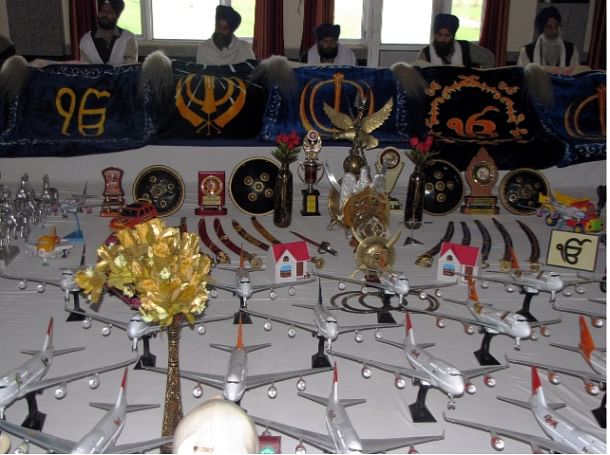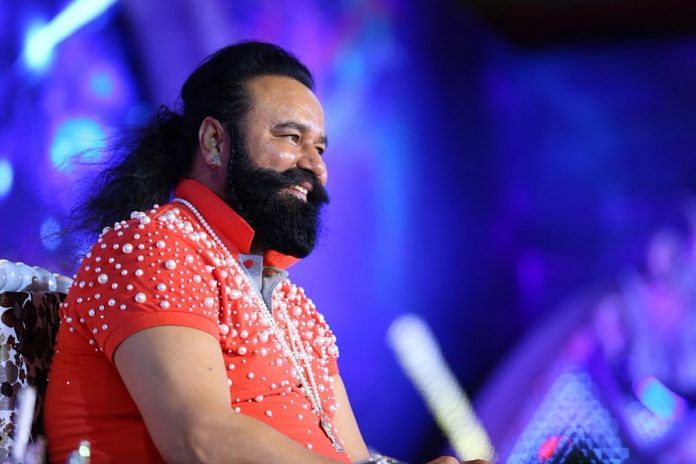Deras in Punjab assume unique importance during election time, and there is hardly a village or town in the state without one. So, Dera Sacha Sauda’s chief Gurmeet Ram Rahim’s release on furlough from Haryana’s Rohtak jail last week just before the Punjab assembly election has raised some eyebrows. Ram Rahim and his Dera have previously backed political parties and come with mass Dalit following with influence in Punjab’s Malwa region. It also points to the electoral significance of these deras.
Leaders of almost all political parties make multiple visits to deras in the hope of garnering votes wholesale. Ahead of the upcoming Punjab polls, Sach Khand Ballan has become one of the most frequented deras, courtesy Charanjit Singh Channi, the chief ministerial face of the Congress. Almost all leaders have made repeated visits to its huge complex in the outskirts of Ballan village near the Bhogpur town of Jalandhar district. Channi even spent a night at this dera, underlining his community affiliations with the majority (Ravidassias Dalit) followings of the Dera Ballan. Now, even Prime Minister Narendra Modi has met Gurinder Singh Dhillon of the Radha Soami Satsang Beas.
So, what are these deras and how do they gain power?
Earlier today, I had the honour of meeting Baba Gurinder Singh Dhillon Ji of the Radha Soami Satsang Beas. The social service initiatives of the RSSB are commendable. pic.twitter.com/OIBiMSrxhR
— Narendra Modi (@narendramodi) February 13, 2022
Deras for poor, oppressed and immigration
The word dera originates from the Persian word ‘derah’ or ‘dirah’. Resembling ashrams, maths, viharas, shrines, monasteries, convents, communes and pagan sites, a dera is a residence/camp or settlement of a sant/monk/mahant/baba/guru who is supposed to be a person of high moral and spiritual values. They also have a certain political aura. Generally considered above the structural bindings of institutionalised religions, deras are alternative religious sites where people, particularly belonging to oppressed castes, economically poor, deprived and unprivileged sections of society, throng not only for religious respite, but also for social and cultural gratifications. Deras cultivate a feeling of cohesiveness among their diverse followers and generate innovative cultural capital and cult-based identity overriding people’s erstwhile social and political identities. They also offer a common platform for the convergence of political elites and commoners, and provide fresh algorithms to influence electoral politics.
The erosion of the age-old institution of extended families, withering of the welfare State, widening of inequalities in the wake of neo-liberal reforms of the early 1990s together with continuing caste discriminatory practices drove people to throng deras of varied nomenclatures. This pronounced tilt among the poor and oppressed castes towards deras has made them highly influential in a society where the boundaries between religion and politics are often blurred.
The prevalence of an oppressive patriarchal order was yet another cause that propelled many towards deras to seek blessings of the Gaddi-Nashins (spiritual heads) for the birth of a male child and also their mehar (grace) to excel in worldly endeavours. Many, especially women, also visit deras to seek the grace and support of the heads of deras to rid their family members of drug addiction and other social/psychological ailments. Others visit deras seeking blessings to emigrate. There are even deras where gullible seekers are bestowed toy airplanes as recognition of their mannat (wish) to go abroad, along with an implicit promise of success.

Political reach of deras
The increasing popularity of deras led to patronage from various political parties, which, correctly, perceived the massive followings as potential votebanks. Over the years, many deras have been able to raise mammoth infrastructures – hospitals, de-addiction centres, schools, technical training centres, local transport system, weekly magazines, and libraries. They have also chiseled distinct rituals, ceremonies, slogans, symbols, auspicious dates, customs, prayer, kirtan (musical rendering of sacred hymns), religious festivals and iconography. Through such distinct identity markers, deras develop alternative social discourses and regularly organise religious congregations attended by large numbers of followers. Babas of deras, who mesmerise devotees with their pravachans (religious sermons) and kirtan, become popular not only among masses, but also, de facto, in political circles. The mass following of deras almost compel politicians into making a beeline at these sprawling socio-spiritual campuses, for electoral favours.
Different kinds of deras
Sufi and Ravidass deras
The rise of deras in Punjab is not a new phenomenon. Its origin can be traced to the entry of the Sufis in the northwest region of medieval India. Deras of sufis are also called khanqahs. There are around 260 Sufi deras/khanqahs in contemporary Indian Punjab. There are many deras associated with the Sants (sages) of the Bhakti movement. Since many of the Sants of this movement were from the lowest castes, their deras became popular among Scheduled Castes (SCs). Among them, Ravidass deras are the most populous in the region.
They began emerging in Punjab in the early 20th century, and there are approximately over 100 Ravidass deras in Punjab. The Sants of dera Sach Khand Ballan, the ace Ravidassia Dera, laid the foundation stones of almost all of them. It is pertinent to note that Ravidass deras have come up not merely as centres of spiritual gatherings for SCs, but have also metamorphosed slowly into epicentres of social protest and Dalit consciousness.
Also read: Dera chief Ram Rahim gets 21-day furlough from jail, Haryana govt says no link with polls
Sikh deras
Punjab is also known for a large number of historical Sikh deras of Udasis, Minas, Dhirmalias, Ramraiyas, Handali, and Massandis. All of these deras were primarily the outcome of unsuccessful and disgruntled claimants who had each previously sought to be recognised as a Sikh Guru. Apart from these early sect-based deras, many more deras emerged at different intervals along the long and tortuous journey of the consolidation of the Sikh religion. Some of the most prominent among them were Bandei Khalsa (Bandapanthis), Nanakpanthis, Sewapanthis, Bhaktpanthi, Suthrashahi, Gulabdasi, Nanaksar Kaleran, Nirmalas and the Nihangs.
In Sikh deras, the Sikh rahit (code of conduct) is observed strictly. A majority of their followers come from the Jat Sikh community. It is rare that the head of a Sikh dera would be a non-Jat Sikh. Even if there is one, he could never be from an SC community. At the most, SC Sikhs’ participation in Sikh deras is confined only to various kinds of menial services. The narration of the sacred text (Sri Guru Granth Sahib) and performing of kirtan are also mostly managed by SC Sikhs, and few Jat Sikhs take up such professions. In the Sikh deras, only gurbani from Sri Guru Granth Sahib is recited.
Non-Sikh deras
A large number of non-Sikh deras also emerged in the late 19th and early 20th century in Punjab. These non-Sikh deras do not follow the Sikh code of conduct and have formulated their separate ritual practices. Dera of Radha Soami Satsang, Sacha Sauda, Nirankaris, Namdharis, Divya Jyoti Jagrati Sansthan, Murad Shah, Almast Baba Lal Badshah, Vadbhag Singh and Bhaniarawala are most prominent among them. Though a majority of their followers come from SC communities, backward castes and poor Jat Sikh peasantry, their command remains in the hands of the dominant castes.
Among them, the chief of the Nirankari deras belonged to the Khatri caste, and that of the Sacha Sauda and Radha Soami come from the Jat Sikhs of the Sandhu and Dhillon sub-castes respectively. These contemporary non-Sikh deras became popular among the oppressed castes because of their non-discriminatory attitudes towards them. What distinguished the contemporary deras from their earlier counterparts is that the former have become popular sites of Dalit mobilisation and resistance.
Put together, Sikh and non-Sikh deras exist in over 9,000 of the approximately 13,000 villages of Punjab. The persistent humiliation of the oppressed castes at the hands of the dominant castes, despite the fact that many of them have improved their economic conditions, is often considered as an important factor behind the mushrooming of deras in Punjab and their Dalit followings.
Also read: Malwa, Majha, Doaba: Divided by rivers, each Punjab region has distinct political identity
How deras influence elections
While there is no standardised methodology to map the influence of deras on the 2022 Punjab assembly elections, there is a general impression that the Congress may garner significant support, especially from Ravidass deras led by Sach Khand Ballan. However, the chances of BJP garnering political support from the followers of Ram Rahim’s Dera Sacha Sauda seem to have improved profoundly after the recent 21-day release of its head, Gurmeet Ram Rahim Singh, on parole from Sunaria jail in Haryana where he is doing time for murder and rape.
Although Dera Radha Soami remains detached from the humdrum of politics, given the fact that majority of its followers hail from oppressed castes, there is a possibility of a slight tilt in its inclination towards the Congress party. Nevertheless, as far as the SAD (Badal) is concerned, it will get support from various Sikh/Shiromani Gurdwara Prabandhak Committee-dominated gurdwaras and deras. Gurmat Sidhant Pracharak Sant Samaj, in a meeting of around 300 Sikh preachers recently held in Jalandhar presided over by Sant Harnam Singh Khalsa, the chief of the Damdami Taksal, announced its support for the SAD-BSP alliance in the forthcoming assembly elections.
Ronki Ram is Shaheed Bhagat Singh Chair Professor of Political Science, Panjab University, Chandigarh, and Visiting Professor, Faculty of Arts, Business and Social Sciences, University of Wolverhampton (UK). Views are personal.
(Edited by Neera Majumdar)



